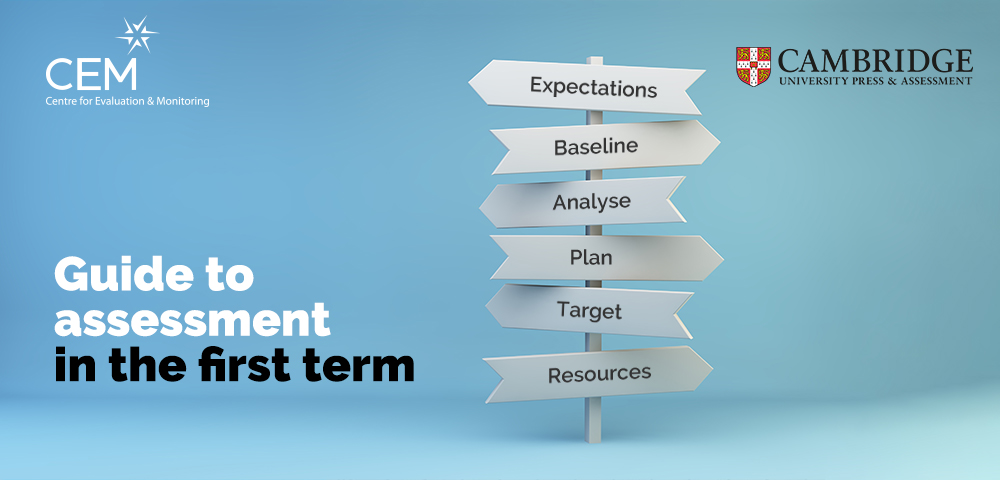Guide to assessment in the first term
By: Cambridge CEM on Oct 4, 2021 2:19:00 PM
4 min read

The beginning of a school year is always the busiest. There’s so much to consider and do and plan and prepare for that it can feel overwhelming. Juggling all the responsibilities of teaching and feeling like you’re on top of it all may seem like an impossible feat. And the thought of doing an assessment right at the start of the year probably doesn’t help.
A baseline assessment though may be just the thing to help you sail smoothly through your first term. It’s not just another test that will take away from your precious teaching time. Baseline assessments complement the teaching you already do and are there to come back to, to guide and support you throughout the year.
So how does a baseline assessment fit into the busy beginning of the year? And how can you get the most out of it?
Getting the right start
Keep your first week back assessment-free. It’s the new year, your new class, fresh faces full of all the excitement, nerves and anticipation for the year ahead. Get to know your students, start building relationships, set out your expectations and routines.
A good knowledge and understanding of your students, their personalities and backgrounds, is a huge help when it comes to analysing their assessment data. It gives you context and a much bigger picture of their learning. Enjoy this week, it may be tiring and full-on but the long-term benefits are so worth it.
Time to assess
Introduce the baseline assessment before your students take it. Explain the purpose of the baseline is not to judge them but to give you a better understanding of how you can best support their learning.
Depending on class sizes and resources available, it may take up to two weeks to make sure everyone in your class completes their assessment. The actual test will take less than an hour for secondary students. In primary, where the assessment is split into sections, multiple sessions may be required. Consult with your colleagues and find out the arrangements so you can be prepared and build in the time – neither you nor your students will want to feel rushed or like it’s something that has to be squeezed into the timetable.
Questioning the data
A healthy data culture in school means that you won’t be expected to dive headlong into the data (although CEM results data is normally available within 48 hours of a student completing their assessment).
Talking through the reports with your colleagues, using it to ask questions and sharing ideas about what it could mean for your students can help inform your teaching and planning. And it can help confirm your target setting, alongside your own knowledge of your students and your observations of their work in class.

Key questions to ask
- Do you recognise the student in the data?
- Is there anything surprising about the results?
- How will you use the information the results give you?
Please – whatever you do – don’t just look at the reports, fill in a spreadsheet for your senior leadership team and then forget about them! That way leads to stress, resentment, overworked teachers and a minefield of misconceptions. If you are interested in developing your data literacy skills, there are several CPD opportunities out there that can help build up your confidence, like this Understanding Assessment course from Cambridge Assessment Network.
Teaching to maximise learning
With all the information and support from the data behind you, you can concentrate on the most important job – teaching to maximise learning for every student in your class. The data is there to inform your daily planning, to make sure the right interventions are in place to address the right needs and that you have the most effective resources available.
Do the medium-term and long-term plans you made at the very start offer the opportunities for every learner to work on their targets?
Build the bigger picture
Once the initial rush at the start of the year is over and you have the baseline data and your routines in place, it’s time to conduct your own assessments. Whatever form these assessments may take, you can compare the results to the baseline data and see the progress your students are making.
If you have a parents’ evening coming up, having the baseline data in front of you gives a great starting point for a discussion around their child’s learning. It’s also a great tool to ensure that you’re all on the same page when it comes to what goals their child is working towards and what support they need in order to achieve.
Six weeks can go by in the blink of an eye in school. There’s so much to cram in and teachers manage it year after year. It really is amazing just how much progress can be achieved in such a short time.
So while baseline assessments give you an insight into your students’ skills and abilities at a particular moment in time, they also give you a foundation from which to build your students’ learning and shape your teaching. Celebrate and embrace baseline assessment in the beginning to set you up for a great year of teaching and learning.
Want to find out more about baseline assessment?
Related Posts
Assessment in English
By Zoe Enser Assessment is one of the most important things we do in the classroom. It is part of...
A complete and effective assessment cycle
Assessments are a vital part of school life. There are many different types of assessments, they...
Teachers need greater support in order to understand and maximise the value of assessment in their classrooms
A new report, Testing the Water: How assessment can underpin, not undermine, great teaching,...

